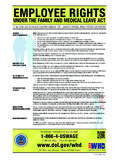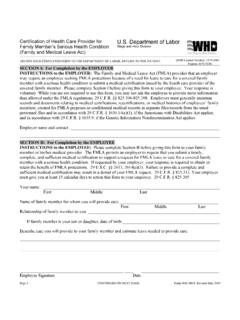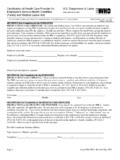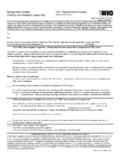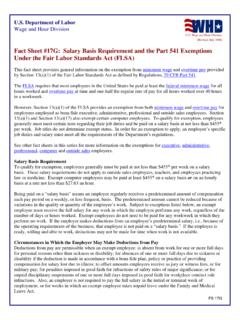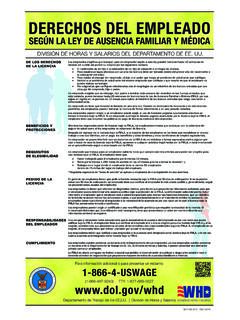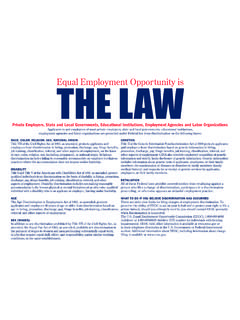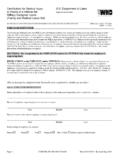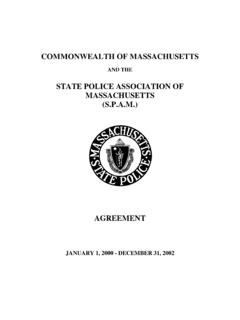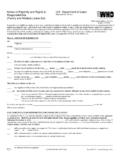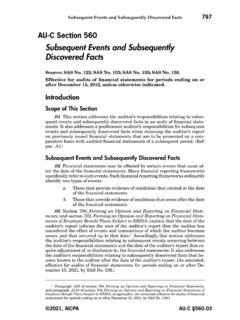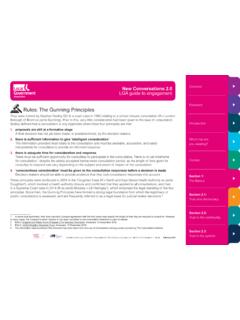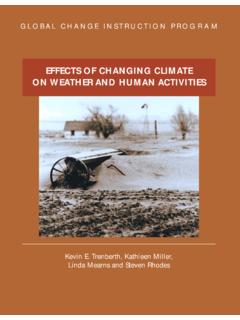Transcription of FAQs on SSA Potential Private Retirement Benefit ... - DOL
1 FAQs on SSA Potential Private Retirement Benefit Information Department of Labor Employee Benefits Security Administration I received an SSA Potential Private Retirement Benefit Information notice. What does this mean? This notice was sent to you by the Social Security Administration (SSA) because you filed a claim for social security benefits. It is a reminder about Private employer Retirement benefits that you have earned, also called "deferred vested benefits". The Internal Revenue Service (IRS) provided this information to SSA. The information is provided to the IRS by the plan administrators of the Private Retirement plans that you participated in while you were an employee. You may have already received some or all of these benefits.
2 You should review the plan information on this notice and contact the plan administrator identified to make a claim for any benefits due to you. When should participants expect to receive distributions from their Retirement plans after terminating employment? Generally, the law requires plans to pay Retirement benefits no later than the time a participant reaches normal Retirement age. But, many plans -- including 401(k) plans -- provide for earlier payments under certain circumstances. For example, a plan's rules may allow participants in a 401(k) plan to receive payment of benefits after terminating employment. The plan's Summary Plan Description (SPD) should set forth the plan s rules for obtaining the distribution as well as the timing of distribution after termination of employment.
3 Can an employer sponsor more than one type of Retirement plan? Might I be eligible for Retirement benefits under more than one plan? What if I am already receiving Retirement benefits? Yes, an employer may, but is not required to, sponsor more than one type of Retirement plan, such as a 401(k)-type plan and a traditional pension plan. If your former employer sponsored more than one type of plan, you may be eligible for Retirement benefits from more than one plan. For example, you may have received benefits from a 401(k) or other defined contribution plan at the time you terminated employment, but still be due benefits from a traditional pension (defined Benefit ) plan. Check with the plan administrator listed on the notice to determine if you have benefits owed to you.
4 Generally speaking, there are two types of Retirement plans: defined Benefit plans and defined contribution plans. A defined Benefit plan promises you a specified monthly Benefit at Retirement . The plan may state this promised Benefit as an exact dollar amount, such as $100 per month at Retirement . Or, more commonly, it may calculate a Benefit through a plan formula that considers such factors as salary and service - for example, 1 percent of your average salary for the last 5 years of employment for every year of service with your employer. A defined contribution plan, on the other hand, does not promise you a specific amount of benefits at Retirement . In these plans, you or your employer (or both) contribute to your individual account under the plan, sometimes at a set rate, such as 5 percent of your earnings annually.
5 These contributions generally are invested on your behalf. You will ultimately receive the balance in your account, which is based on contributions plus or minus investment gains or losses. The value of your account will fluctuate due to changes in the value of your investments. Examples of defined contribution plans include 401(k) plans, 403(b) plans, 2 employee stock ownership plans, and profit-sharing plans. The general rules of ERISA apply to each of these types of plans, but some special rules also apply. You should review the plan name and information on the notice and contact the plan administrator to make a claim for these benefits. If you are already receiving benefits from the named plan, then you may disregard this reminder notice.
6 If the contact information in my notice is not current, how can I find current information? Visit the Department of Labor's Web site to find the most recent annual report filed by your plan, which includes the plan administrator's contact information, or contact a Benefits Advisor as noted below for assistance. What if this notice i s addressed to my deceased husband or wife? Can a Benefit continue for the spouse if the employee dies first? ERISA provides some protection to surviving spouses of deceased participants who had earned a vested Retirement Benefit before death. The nature of the protection depends on the type of plan and whether the participant dies before or after payment of the Benefit is scheduled to begin, otherwise known as the annuity starting date.
7 In a defined Benefit or money purchase plan, unless you and your spouse choose otherwise, the form of payment will include a survivor s Benefit . This survivor s Benefit , called a qualified joint and survivor annuity (QJSA), will provide payments over your lifetime and your spouse s lifetime. The Benefit payment that your surviving spouse receives must be at least half of the Benefit payment you received during your joint lives. If you choose not to receive the survivor s Benefit , both you and your spouse must receive a written explanation of the QJSA and, within certain time limits, you must make a written waiver and your spouse must sign a written consent to the alternative payment form without a survivor s Benefit .
8 Your spouse s signature must be witnessed by a notary or plan representative. In most 401(k) plans and other defined contribution plans, the plan is written so different protections apply for surviving spouses. In general, in most defined contribution plans, if you should die before you receive your benefits, your surviving spouse will automatically receive them. If you wish to select a different beneficiary, your spouse must consent by signing a waiver, witnessed by a notary or plan representative. If you were single when you enrolled in the plan and subsequently married, it is important that you notify your employer and/or plan administrator and change your status under the plan. If you do not have a spouse, it is important to name a beneficiary.
9 If you or your spouse left employment prior to January 1, 1985, different rules apply. What if my former employer has closed, was sold, or declared bankruptcy. How do I find more information about my Potential Retirement benefits? If a plan is terminated -Federal law provides some measures to protect employees who participated in plans that are terminated,both defined Benefit and defined contribution. When a plan is terminated, the current employees mustbecome 100 percent vested in their accrued benefits. This means you have a right to all the benefits thatyou have earned at the time of the plan termination, even benefits in which you were not vested andwould have lost if you had left the employer. If there is a partial termination of a plan, (for example, ifyour employer closes a particular plant or division that results in the end of employment of a substantial3 percentage of plan participants) the affected employees must be immediately 100 percent vested to the extent the plan is funded.
10 If the terminated plan was a defined Benefit plan and it d id not have enough money to pay the benefits - The Federal government, through the Pension Benefit Guaranty Corporation (PBGC), insures most Private defined Benefit plans. For terminated defined Benefit plans with insufficient money to pay all of the benefits, the PBGC will guarantee the payment of your vested pension benefits up to the limits set by law. For further information on plan termination guarantees, contact the Pension Benefit Guaranty Corporation toll free at 1-800-400-7242, or visit the Web site. If the terminated plan was a defined contribution plan - The PBGC does not guarantee benefits for defined contribution plans. The defined contribution plan fiduciaries and trustees should have taken actions to pay out the plan s assets.
